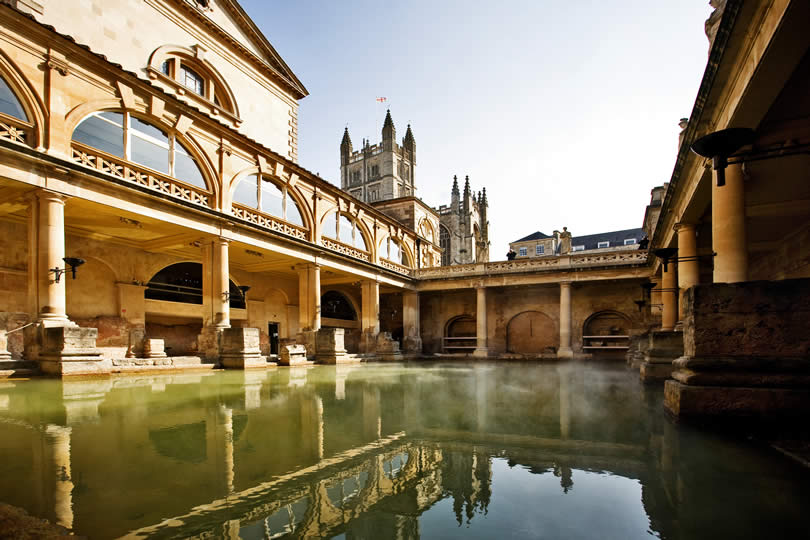Bath England Roman Baths
8 Tips for visiting the Roman Baths and Pump Room in Bath UK
The Roman Baths and Pump Room in Bath are a major tourist attraction receiving well over 1 million visitors a year. The healing hot springs have attracted people to the area for centuries, spanning back to the Celts who built the first shrine on the site.
Around 70 AD the Romans developed the hot springs into a grand bathing and socialising spa which is today one of the world’s best preserved Roman spa remains. When the Romans left Britain, the baths were no longer used and fell into disrepair. It was only towards the end of the 18th century when bathing became fashionable again that the grand Georgian building was constructed to house the city’s ancient “watering hole”.
Make the most of your visit to the Roman Baths and adjoining Pump Room and follow our helpful top tips to maximise the experience.
1. When to visit?
The busiest times to visit the Roman Baths and Pump Room is during the peak summer tourist season during the months of July and August. However during these months the Baths stay open until 10pm and the evenings can be blissfully quiet from about 5pm when the majority of visitors leave.
If possible, it is advisable to plan your visit for a weekday as the weekends can very busy. Depending on the time of year the opening times are 9am or 9.30am and this maybe the least busy time of the day to look round the baths. Queues of up to half an hour can be expected during the main summer months.
2. Best ticket deals
There are a variety of admission tickets available for the Baths. The family ticket (two adults and up to four children) is good value and can save you up to £24. The Saver Ticket is well worth considering if you also intend to visit the Victoria Art Gallery and Fashion Museum Bath within a 2 week period.
At the Fashion Museum, located in the Assembly Rooms in the centre of one of Bath’s most elegant Georgian terraces, you can view their world-class collection of historical and contemporary clothing. The Victoria Art Gallery is nearby, close to the historic Pulteney Bridge, and contains a stunning collection of word-class art and sculpture.

3. Free Tours
Your admission ticket entitles you to join the free guided tours of the Baths that start at the Great Bath and commence hourly. Your ticket also entitles you to pick up an audio guide which is available in 8 languages including Italian, French, Spanish and German.
One of the English guides is narrated by bestselling author Bill Bryson who adds his own witty thoughts and suggestions on all things Roman. As you walk round the Roman spa complex you just key in the name of the room you are or the room number and a full description is given.
If you want more historical depth there are many additional commentaries you can select that go into much greater detail about specific objects. For most visitors the tour will take about one hour, if you listen to the extra audio commentaries the time taken can take up to about 90 minutes.
4. Experience a real Roman Spa day!
The heart of this Roman spa is the impressive open air Great Bath. Its is a lead lined pool, 1.6 metres deep, and filled with steaming, naturally heated ‘Sacred Spring’ water. Over a million litres of geothermally heated hot water still naturally pours into the pool every day.
In Roman times it would have been covered by a substantial high barrel vaulted roof reaching 45 metres high. There are more bathing pools where excavated sections reveal the sophisticated hypocaust system that was used to heat the bathing and changing rooms.
After bathing the Romans would take an invigorating dip in the cold water plunge pool, visitors can watch life size videos of Roman bathers that are projected onto the walls of this room.

5. Children friendly
A fascinating interactive museum displays Roman artefacts discovered on the spa site and in the local area. Children will enjoy chatting to the costumed Roman characters who patrol the Baths and retell their ancient stories.
These characters are based on real Romans, such as soldiers, slaves and stonemasons, who worked and lived at the Baths 2,000 years ago. There are also award-winning audio guides designed specifically for children.
6. Dining in style
The Roman Baths has 2 options for refreshments, the elegant 18th Century Pump Room and just opposite the main entrance the Georgian Roman Baths Kitchen. Taking afternoon tea in the magnificent neoclassical Pump Room, with its soaring Corinthian columns, is an experience not to be missed.
Relive the refined times of old with crisp linen tablecloths, fresh flowers, table service and listen to the Pump Room Trio (piano, violin and cello) who play every day.
Both venues serve traditional British food prepared on the premises using local produce, and are open all day.
7. Stay later to experience the Baths in torchlight
A magical touch is when at dusk each day the torches that are positioned around the baths are lit. The flickering torches create a wonderful atmosphere as they cast shadows on the statues and carved gorgon’s, and illuminate the ancient pavements.
During the winter months they torches are lit around 4pm and in the summer they are lit at about 9pm.
8. Sample the healing waters
Visitors are invited to partake in tasting the spa water in the Pump Room, included as part of the admission fee.
The unique waters are believed to have curative powers as they contain over forty minerals. Be warned, the water from the Spa fountain has a rather unusual taste!


